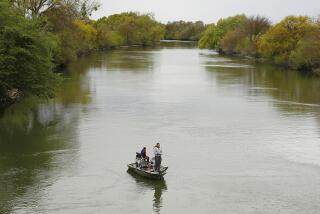New Orleans Should Be Dry by End of the Week
- Share via
NEW ORLEANS — The vast floodwaters that inundated four-fifths of New Orleans have been almost entirely pumped out of the city, with the remainder expected to be gone by the end of the week, the Army Corps of Engineers said Sunday.
The corps estimated that it had pumped out 87% of the water from within the city, representing much faster progress than the agency had previously reported. Some areas outside the city remain flooded. Col. Duane Gapinski, who is leading the effort to drain the city, said the situation was helped dramatically by three weeks of little or no rainfall since Hurricane Katrina ruptured the city’s levee system.
“We are getting close to completing the job in the city,” he said.
The corps estimates that about 2,700 acres of the city remain flooded, down from 27,000 acres immediately after the hurricane. The water is concentrated in three large pools, 2 to 4 feet deep -- in East New Orleans, the northern section of the central city, and the 9th Ward -- and should be gone within five days, Gapinski said.
A tour of the Lower 9th Ward on Sunday revealed only a few small puddles. On the city’s eastern flank, St. Bernard Parish, though dry, has black mud 2 feet deep in places. Army trucks are plowing the roads for passage.
Many once-flooded sections of the city have dried out, including the Lakefront area along Lake Pontchartrain. Residents began streaming back this weekend to look at their homes; the destruction they found was sobering. Many streets were blocked entirely by trees, vehicles and mud up to a foot deep.
In and around the French Quarter, portable pumps continued to draw water from flooded basements, their hoses snaking across sidewalks. Farther out from the city center, the siphoning work had been largely completed, allowing restaurants and stores to open for the first time since the hurricane. In areas south and west of downtown, utility crews navigated streets still inches deep in mud, restoring power to some businesses and homes.
Although the weather has helped so far, Gapinski said, the corps was carefully watching Tropical Storm Rita, which is off the Bahamas but could reach the Gulf of Mexico. Miles of levees were left devastated by Katrina, and portions of the city are almost defenseless against another storm.
Even if Rita did not hit New Orleans, heavy rains from the storm would complicate the job of pumping out the city’s water. Every inch of rain causes many times that amount to accumulate in low-lying areas, extending the pumping schedule.
The National Oceanic and Atmospheric Administration estimated that 28.6 billion cubic feet of water inundated the city Aug. 29. Only 3 billion to 4 billion cubic feet remain.
The pumping is being done by the New Orleans Sewerage and Water Board, which has been working around the clock to get its pumping stations back on line, Executive Director Marcia St. Peters said. She said 300 of the agency’s employees had been staffing the pumping stations.
In addition to the 22 permanent pumping stations throughout the city, dozens of high-capacity portable pumps were ordered by federal officials. As floodwaters recede, the portable pumps are positioned around the city to empty smaller pools of water.
The new estimates sharply reduce the most recent timeline issued by the corps. Originally, the corps estimated that pumping out the city could take three to six months. A week after the Aug. 29 flood, it shortened that estimate to 80 days.
In Plaquemines Parish, southeast of New Orleans, large swaths of land remain underwater, but the corps expects to have the area dry by Oct. 1. Three levee breaches in the parish caused flooding. Two of those have been temporarily repaired, and the other should be sealed this week, the corps said.
A helicopter tour of the area Friday showed hundreds of cows and horses grazing on the tops of earthen levees. In one community, workers were burning livestock carcasses, using old tires for fuel.
Many of the parish’s hard-hit pumping stations are coming back on line. A four-man crew from the Netherlands arrived last week to assist the Army engineering corps.
It brought high-capacity pumps that the U.S. shipped to the Netherlands in 1953 to help the nation deal with catastrophic flooding from the North Sea.
The Dutch team was working at East Pointe a la Hache, where the permanent pump station is inoperable and diesel engines had been inundated.
“These wetlands are similar to Holland,” said Jaap Von Wissen, a Dutch crisis manager leading the effort.
“Floods can happen anywhere.”
More to Read
Sign up for Essential California
The most important California stories and recommendations in your inbox every morning.
You may occasionally receive promotional content from the Los Angeles Times.














